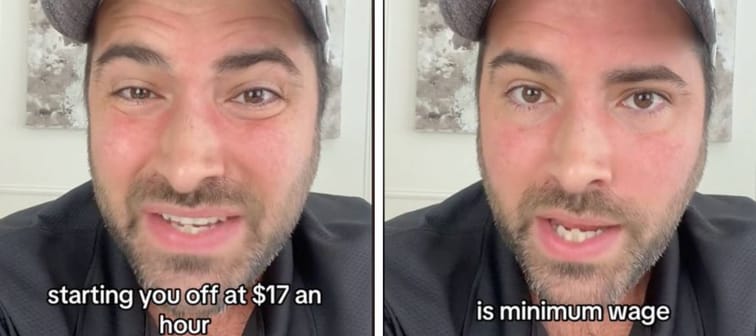The math
In his video, Smith calculates what $17 per hour gets you. One thing he calculates is that $17 per hour comes to a total of $2,300 a month after taxes.
He isn’t too far off. You’ll make around $2,720 before taxes at the lower-income wage of $17 per hour, which comes to $32,640 per year before taxes.
This salary puts this hypothetical person in a federal tax bracket of 12%, according to the IRS. If the hypothetical person lives in Florida, like Smith, they won’t have to pay a state income tax, according to the Florida Department of Revenue. So the person’s take home pay every month, after the 12% federal tax, comes to $2,393.60.
Comparatively, the middle-income wage $50 per hour comes out to an annual salary of $96,000 before tax and you fall into the 22% federal tax bracket. After tax, you’ll end up with $6,240 every month.
Let’s see how these two salaries stack up when you consider the monthly expenses Smith highlights in his video: shelter, food and child care.
Meet Your Retirement Goals Effortlessly
The road to retirement may seem long, but with WiserAdvisor, you can find a trusted partner to guide you every step of the way
WiserAdvisor matches you with vetted financial advisors that offer personalized advice to help you to make the right choices, invest wisely, and secure the retirement you've always dreamed of. Start planning early, and get your retirement mapped out today.
Get StartedHousing
Smith’s estimate assumes a hypothetical rent of $2,000 a month. He isn’t too far off. Rental platform Zumper reported that the median rent for a one-bedroom in the U.S. is $1,505.
If you own a home, the average U.S. mortgage payment is $2,317 a month, according to a 2023 LendingTree survey. This would essentially put homeownership out of reach for the lower-wage worker, but is possible for a middle-wage worker. However, there is a growing trend of rich Americans who are ditching their plans of home ownership in favour of renting, in part due to high home prices and mortgage rates.
If you think about the old adage that says housing shouldn’t be more than 30% of your income, then you can see the impact high housing costs are having on the budgets of lower-wage workers — and how, by that classic benchmark, many middle-income workers are now rent-burdened as well.
Food
In his video, Smith estimates that food costs $1,000 a month. This number is accurate if you assume multiple people are living in the household, but for one person, it appears to be an over-estimation.
According to a recent survey from moving company Move.org, the average monthly cost of food per person comes to $415.53. This means that lower- or middle-wage workers could at least put food on the table.
Even so, the BLS reports that food has jumped 8.4% since 2021 – and people are feeling it. Over 60% of Americans are struggling with putting food on the table, according to a 2023 report from research company Attest. Over 9% of people have “a lot of difficulty” affording food, but over 50% only have difficulty some of the time – which tracks with the average food costs above.
This 2 Minute Move Could Knock $500/Year off Your Car Insurance in 2024
Saving money on car insurance with Bestmoney is a simple way to reduce your expenses. You’ll often get the same, or even better, insurance for less than what you’re paying right now.
There’s no reason not to at least try this free service. Check out BestMoney today, and take a turn in the right direction.
Get StartedChild care
Smith says that parents pay around $2,000 a month for child care. He’s not totally off, but it’s around $833.33 per month, with child care costing on average $10,000 per child per year. Even though the numbers above for food and shelter assume a person lives alone, child care means that there’s at least one more person in the household – and that contributes to higher household costs outside of just child care.
Just that $833 for child care is too high a cost for that lower-wage worker to shoulder alone; and even for a worker earning almost three times as much, it’s still a significant portion of their monthly income.
However, if you factor in paying for two kids at the average rate ($1,666) or three kids ($2,499), then you’re starting to see how a lower-income worker can’t afford to put their kids in child care. Even a middle-wage worker would be spending nearly half their paycheck on child care if they have three kids.
So does it add up?
Just accounting for the average costs of rent for a one-bedroom, food for one person and child care for one kid, your total expenses would come to around $2,753.86.
Assuming the monthly incomes stated in the above examples, that worker making $17/hour will not be able to cover basic living expenses on their income alone. Someone making what Smith dubs the new “middle-class wage” of $50/hour (around $6,000 a month) can survive, save some money and have some fun.
So it seems that Smith is in fact on to something, even if his own estimates swing high.
The data shows a person cannot shoulder the country’s average monthly expenses alone if they make $17/hour and child care is involved.
Even without the added child care costs, the average single American living alone would only be left with a few hundred dollars for anything outside of food and shelter, including other bills like utilities and car insurance or any emergency expenses that might crop up.
This also means other possible monthly budget concerns like paying off debt or stashing away money in a savings account could be out of reach completely. And even those earning higher incomes are increasingly unable to do more than live paycheck to paycheck.
Sponsored
Follow These Steps if you Want to Retire Early
Secure your financial future with a tailored plan to maximize investments, navigate taxes, and retire comfortably.
Zoe Financial is an online platform that can match you with a network of vetted fiduciary advisors who are evaluated based on their credentials, education, experience, and pricing. The best part? - there is no fee to find an advisor.







